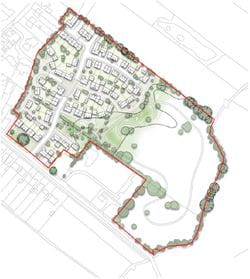Six years after the Government consolidated 1,000 pages of national policy guidance into just 50, an updated version of the National Planning Policy Framework (NPPF2) has just been published. Over the last six years there has been considerable litigation and challenge and in the updated NPPF, the Government has attempted to maintain simplicity as well as provide clarity.
This briefing note sets out our views on the headline changes, the implications of these and commentary on some
of the things that didn’t change which we think should have.
It's all about the housing market stupid!
With apologies to Bill Clinton’s 1992 Presidential Campaign, NPPF2 has restated the Government’s commitment, and some would say obsession, with housing delivery, both in terms of supply and for the first time, delivery.
On supply, as promised, the Government is committed to introducing a standard methodology for assessing local housing need. There are plenty of critics of this approach, but it was argued that it would at least make the system consistent. Except it won’t, because a get-out clause is included with a deviation allowed where “exceptional circumstances justify an alternative approach which also reflects current and future demographic trends and market signals”. So in some cases, expect nothing to have changed at all and for all sides at local plan examinations to seek to demonstrate exceptional circumstances and thus argue that a standard methodology is not appropriate. So much for the benefits of introducing a standard methodology!
At the other end of the process is the new housing delivery test. This is new and challenges local planning authorities to maintain housing delivery. This would be a fair test if delivery rested wholly with the authority, but as delivery is reliant on a wide range of factors including the performance of developers and market conditions, some may conclude it is a little harsh to punish a local authority for matters which may on occasions be outside of its control. Expect considerable research and monitoring on this. Also, expect a renewed effort at ensuring Local Plans are up to date and reviewed in a timely fashion.
So how many houses do we need?
The Government’s housing target has been set at 300,000 units per annum based on previous household projections (2014). This has been at the heart of all Government statements about the housing market over the last couple of years.
However, new household projection data is planned to be released in September (2016 data) which is understood to be likely to lead to a reduced national target. So if the national target is going to go down, we can expect local targets to have to be adjusted and there is of course now the potential to argue exceptional circumstances depending on whether or not you are supporting or opposing growth. Expect further clarification on this and for many debates to start at a local level on housing needs for a particular area.
Additional test for local authorities considering changes to Green Belt boundaries
Local communities and Central Government have increasingly been alarmed at the apparent ease with which local planning authorities have undertaken reviews of Green Belt boundaries. The previous test required Green Belt boundaries to be reviewed only in “exceptional circumstances”, and local planning authorities often considered the test to have been satisfied because of a need to find additional land for housing and there not being enough brownfield land.
It is clear that the Government believed this increasingly to have become a default scenario and so the test has been strengthened to require demonstration of “fully evidenced and justified”exceptional circumstances. One can only surmise at this stage that it means local planning authorities will have to undertake a detailed consideration of the supply of brownfield and other land before considering a review of Green Belt boundaries. We consider that where local planning authorities do anticipate needing to release land from the Green Belt to meet future development needs, this strengthening of the test is likely to lead to considerable scrutiny from communities, landowners and developers, and finally the inspector at the Examination in Public into any draft Plan.
A helpful clarification is that where a strategic plan has proposed changes to Green Belt boundaries, these can be changed in neighbourhood plans. There is also a new opportunity for limited in-filling in villages or the partial or complete redevelopment of previously developed land where this contributes to meeting an identified local affordable housing need, provided this would not cause substantial harm to the openness of the Green Belt. We can see the possibility of this raising anxieties in some locations.
New settlements or significant extensions to towns and villages
Although the guidance on the potential contribution of new settlements or significant extensions to towns and villages is not new, clarification is provided which suggests that the support for these is enhanced. Significantly there is mention of the principles of the Garden Cities movement, which had been absent in the draft NPPF, which suggests that this form of development is again in vogue with the Government. It implies also that councils will be encouraged to support these developments through joint ventures or locally led development corporations. Paragraph 119 suggests the use of compulsory purchase powers by planning authorities as a tool for land assembly. Another one to watch.
Anything for town centres?
There is not much change in relation to town centres with NPPF2 restating their primacy and the need to protect and encourage investment in them. At a difficult time for the High Street, this is unsurprising.
Focus on design, quality and engagement
Good design has been significantly strengthened in NPPF2 as it is “fundamental to what planning and development should achieve” (paragraph 124). Early liaison with planning authorities is promoted and entering into voluntary Planning Performance Agreements for large and complex projects is a new addition. The use of collaborative workshops as one way of achieving early engagement with local communities is suggested. In our opinion, these requirements have the potential to frontload the development process resulting in a more lengthy pre-application process but with possibly greater community buy-in to schemes and a more streamlined determination period. A key addition in NPPF2 is the requirement for planning authorities to ensure quality is consistent from approval to completion. This is likely to result in more detailed submissions and less flexibility on amending design details through the planning condition discharge process. It could also vary the perception of what constitutes a non-material amendment. Could this be the end of post consent value engineering?
Small sites and density
NPPF2 has scaled back the percentage of small sites that should be allocated in a Development Plan and within Brownfield Registers from the 20% proposed in draft NPPF2 to 10%. Sites must not be larger than 1 hectare. A get-out clause has also been inserted for those authorities unable to meet this requirement, no doubt driven by local authorities’ consultation responses. NPPF2 promotes the use of Local Development Orders for small and medium sized sites therefore confirming the acceptability of brownfield developments of 10 plus units on sites less than 1 hectare in size. There is a clear intention of optimising densities in city and town centre locations that are well served by public transport. This is a new addition and reflects sentiments of the draft London Plan. Minimum density standards are suggested for other parts of the plan area. An important addition is direction for authorities to take a flexible approach in applying policies or guidance relating to sunlight and daylight where they would otherwise inhibit making efficient use of a site. This relaxation in approach is welcomed.
Neighbourhood plans
The status of Neighbourhood Plans is clarified following significant litigation and NPPF2 emphasises the need for development to comply with neighbourhood plans. Paragraph 65 sets out that strategic policies should identify a housing requirement figure for designated neighbourhood plan areas and there should be no need to review this at examination stage. The intention here must be to speed up Neighbourhood Plan Examinations. Annex 2 makes it clear that a Neighbourhood Plan is part of the Development Plan unless the planning authority decides it should not be made.
Affordable housing
The definition of Affordable Housing has been amended to include Build to Rent, Starter Homes and discounted market sale housing. Social Rent has been reintroduced under the affordable housing for rent definition, following an earlier disappearance in draft NPPF2. The change of definition for the Build to Rent sector could be particularly important as the tenure becomes more mainstream and which some in the market consider will make a substantial contribution to housing delivery in city and town centres.
Planning obligations & viability
A subtle change in wording sets out that planning obligations ‘must’ only be sought when they meet the CIL Regulation tests. This compares to ‘should’ wording in the draft. This definitive position should make the process of securing obligations more transparent for applicants and local authorities.
Paragraph 57 sets out that the onus is on the applicant to justify a viability assessment and the weight to be given to it is a matter for the local authority. Where local plans are up-to-date, a site is deemed to be viable and therefore any subsequent viability assessments submitted as part of a later planning application could carry less weight. This puts greater importance on accurately promoting sites and making representations to influence draft policy wording through the emerging Plan process. As not all development costs and abnormals are known at the outset, this new weight consideration of viability assessments at planning application stage could actually result in protracted negotiations and slow down housing delivery in the long term.
So what's been missed?
We consider that an opportunity has been missed to be provide much greater flexibility on when changes to Green Belts should be allowed. This would have been helpful to guide the Mayor of London to lead a London wide review of the Green Belt in consultation with neighbouring authorities under the duty to co-operate to provide for a wide range of housing types to meet London’s housing needs.
Nick Taylor
Partner, Planning & Development
020 7016 0733
nick.taylor@carterjonas.co.uk



 The land comprising c. 23.19 ha (53.3 acres) is located on the south western edge of the Cathedral City of Ripon, within the Borough of Harrogate, North Yorkshire.
The land comprising c. 23.19 ha (53.3 acres) is located on the south western edge of the Cathedral City of Ripon, within the Borough of Harrogate, North Yorkshire. Carter Jonas has secured planning permission on behalf of private residential developer Willco Properties Ltd from Epsom and Ewell Borough Council for a new student accommodation development in Surrey. Willco Properties Ltd has an ongoing relationship with the University of the Creative Arts (UCA) to provide high quality student accommodation across Epsom.
Carter Jonas has secured planning permission on behalf of private residential developer Willco Properties Ltd from Epsom and Ewell Borough Council for a new student accommodation development in Surrey. Willco Properties Ltd has an ongoing relationship with the University of the Creative Arts (UCA) to provide high quality student accommodation across Epsom. Carter Jonas’s Planning South team have secured planning permission on appeal, following a 4 day public inquiry, for 72 houses on a site in the north Oxfordshire village of Launton.
Carter Jonas’s Planning South team have secured planning permission on appeal, following a 4 day public inquiry, for 72 houses on a site in the north Oxfordshire village of Launton.





